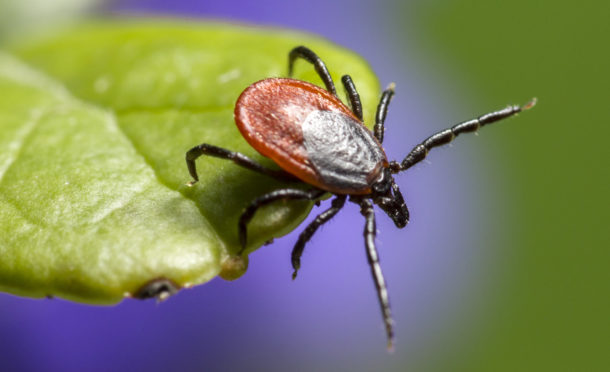The Scottish Government was under fire last night amid accusations they were not doing enough to fight Lyme Disease.
The potentially debilitating disease is spread by tick bites.
MSP and Lyme disease campaigner Alexander Burnett has slammed the government’s awareness campaign after public health minister Joe Fitzpatrick admitted that just “one tweet” was issued by the government in May 2019 about it.
Mr Burnett added: “This Scottish government has been slow to acknowledge the threat of Lyme Disease, how little people know about the disease, and how there is a much higher chance of contracting it in our uplands.
“This had to be pointed out to them by NFU Scotland and the National Institute for Health and Care Excellence in England.
“It’s only human nature that people will feel drawn to the great outdoors as lockdown restrictions are eased.”
But last night, the Scottish Government said they remain “committed” to raising awareness of Lyme disease and other tick borne diseases.
In recent years the disease has become more prevalent due to climate change, increased urbanization and other human impacts on the ecosystem.
The condition comes as result of an insect bite from a tick often caught by people walking in the hill or countryside.
Around 5% of ticks in Scotland are infected with borrelia, the bacteria which triggers Lyme disease in people.
High-risk areas include grassy and wooded areas in the Scottish Highlands and Islands as ticks live in a moist and shady environment.
Every year across the country there are up to 3,000 cases of Lyme disease recorded.
Cases increase during the spring and summer months.
Around 10 to 20% of patients go on to develop a what is known as post-treatment Lyme Disease Syndrome, and suffer from severe debilitating neurological problems, fevers, flu-like symptoms, painful joints and total exhaustion.
Meanwhile a new product, LymeApp, is being created in a project run between Scotland’s Rural College and NHS Highlands.
The product sponsored by European Space Agency will be the first product from a new company, ID MAPPS Ltd, which aims to change peoples’ behaviour for a number of infectious diseases.
The LymeApp app and website will use satellite data and statistics to create zoomable maps of tick occurrence is set to be released early next year.
NHS research project NorthTick is run with the Scottish Lyme Disease and Tick-borne infections Reference Laboratory (SLDTRL) at Raigmore Hospital and with partners across several EU countries.
This three-year project is run to increase awareness of ticks and to stimulate the public sector to generate solutions for improving the public delivery of knowledge, diagnosis and treatment of tick-borne diseases in the North Sea Region.
A government spokesman said that the Scottish Lyme Disease and Tick-borne Infections Laboratory at Raigmore Hospital had been granted Reference Laboratory status to ensure more funding for research and development into the complex infection.
The government added: “The Tick Borne Diseases group is taking forward work to increase knowledge and awareness amongst healthcare professionals and the public, including in high risk areas such as the Highlands and Islands.
“Existing guidance and materials on the NHS Inform website remain relevant for anyone walking outdoors.
“We work closely with Public Health Scotland (PHS) on producing awareness raising material and we will continue to do so once activity around the Covid-19 response has reduced.”
Many celebrities have shared their own stories of living with Lyme disease to help raise awareness.
The bacterial tick-borne illness often comes with symptoms that are typically caused by other health conditions such as rheumatoid arthritis, fibromyalgia, chronic fatigue syndrome, multiple sclerosis.
Earlier this year Canadian pop star Justin Bieber, 26, reflected on a “rough couple of years” while talking about his battle with Lyme in his YouTube documentary series called Justin Bieber: Season.
Singer Avril Lavigne went public with her Lyme battle in 2015 and is now an advocate for those with the illness.
She revealed she had been bedridden in October 2014 as a result of the condition, and called it “worst time” in her life. Specialists and doctors originally misdiagnosed her with chronic fatigue syndrome and depression.
Fellow singer Shania Twain contracted the disease which led to dysphonia a neurological disorder of the vocal cords in which muscles can spasm and impact speech.
And actor Ben Stiller told Hollywood Reporter in 2011 about his Lyme disease.
He said: “I got it in Nantucket, Massachusetts, a couple of years ago.
“My knee became inflamed and they couldn’t figure out what it was, then they found out it was Lyme.
He is now symptom-free but notes that Lyme will never leave his system.

